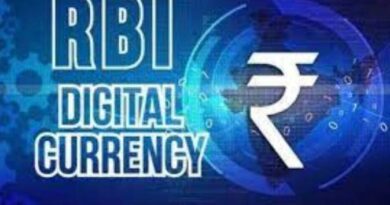“From Rupee to Digital Currency: UPI and CBDC in India”
India’s remarkable digital transformation has been driven by innovative financial technologies and a vision for an inclusive, cashless economy. Two significant milestones in this journey are the Unified Payments Interface (UPI) and the exploration of Central Bank Digital Currency (CBDC). This article delves into how these developments have shaped India’s digital landscape and their potential impact on the nation’s financial future.
The Birth of UPI
In an increasingly digital world, India has emerged as a pioneer in digital payments through its ground-breaking Unified Payments Interface (UPI). UPI has not only revolutionized transactions in India but has also set a global standard for efficient and inclusive digital payment systems.
Conceived and launched by the National Payments Corporation of India (NPCI) in 2016, UPI was a crucial part of the Indian government’s push for a digital economy. UPI simplified peer-to-peer and peer-to-merchant transactions, making them easy, secure, and instantaneous. Users could link their bank accounts to a mobile app and conduct transactions using a unique UPI ID, eliminating the need for cumbersome account numbers and IFSC codes. In August 2023, UPI transactions aggregated to Rs. 10586/- million, with monthly payments valued at Rs. 15,76,536.56crore.
Key Features and Advantages of UPI
Interoperability: UPI stands out for its interoperability, allowing users to transact across different banks and payment service providers seamlessly, fostering healthy competition and choice.
Financial Inclusion: UPI has played a pivotal role in bringing millions of unbanked and underbanked individuals into the formal financial ecosystem, thanks to its user-friendly interface and accessibility through basic smartphones.
Security: UPI transactions prioritize security, with multi-factor authentication and encryption protocols safeguarding user data and funds.
Cost-Effective: UPI transactions are cost-effective, often incurring minimal or zero transaction charges, encouraging small businesses and individuals to embrace digital payments.
The Impact of UPI
The transformative impact of UPI on India’s economy cannot be understated:
Financial Inclusion: UPI has been a driving force behind financial inclusion, granting access to banking services and digital transactions for millions of previously unbanked individuals.
Cashless Economy: UPI has significantly contributed to India’s journey toward a cashless economy, reducing dependence on physical cash and enhancing transaction transparency and accountability.
Fostering Digital Entrepreneurship: Small businesses, start-ups, and entrepreneurs have thrived due to UPI’s ease of use and low transaction costs, empowering them to accept digital payments and expand their operations.
Government Initiatives: UPI has seamlessly integrated into various government initiatives, such as Direct Benefit Transfer (DBT) schemes, facilitating the efficient and transparent disbursement of subsidies and welfare payments.
The Future of UPI
The future of UPI holds great promise:
International Expansion: UPI has ventured into international markets and is poised for further global expansion, solidifying its status as a digital payment standard.
Integration with Emerging Technologies: UPI is expected to integrate with emerging technologies like blockchain and artificial intelligence, enhancing transaction security and efficiency.
Enhanced Merchant Services: UPI is likely to offer enhanced features for merchants, including loyalty programs, invoicing, and inventory management.
Ecosystem Development: UPI’s success will stimulate the growth of a robust fintech ecosystem in India, fostering innovation in financial services.
Central Bank Digital Currency (CBDC): A New Frontier
The exploration of Central Bank Digital Currency (CBDC) represents the next phase of India’s digital journey. CBDC is a digital form of a nation’s fiat currency, issued and regulated by the central bank. In 2022, the Reserve Bank of India (RBI) introduced the Digital Rupee, offering two versions: CBDC- Wholesale and CBDC- Retail.
CBDC-W is primarily intended for select financial institutions, while CBDC-R is accessible to a wider audience. However, the adoption of CBDC has been slower than anticipated.
To promote its digital currency, the e-rupee, the RBI is collaborating with financial institutions to introduce new features, aiming to encourage adoption within the Indian financial ecosystem. Retail CBDC transactions, though gaining some traction, currently average around 18,000 transactions per day, falling short of the RBI’s target.
Proposed features for the e-rupee include enabling offline digital transactions and integrating it with India’s widely used Unified Payments Interface (UPI) to enhance convenience and accessibility.
The RBI is also encouraging interoperability with UPI for the e-rupee through a QR code system, streamlining transactions and making digital currency usage easier for individuals and businesses. Several major banks have already implemented this system.
Key Features of CBDC
Efficiency and Security: CBDC offers increased transaction efficiency and security, reducing risks associated with physical currency and traditional banking.
Financial Inclusion: Like UPI, CBDC has the potential to further financial inclusion by providing a secure digital means of accessing and transacting with the official currency.
Monetary Policy Tools: CBDC equips the central bank with additional tools to implement monetary policy effectively, including influencing interest rates and money supply.
The Synergy between UPI and CBDC
The synergy between UPI and CBDC is notable. UPI has paved the way for the acceptance and adoption of digital financial transactions in India. As CBDC becomes a reality, it can build upon this foundation by providing a secure and government-backed digital currency that seamlessly integrates with other digital payments.
Enhanced Accessibility: CBDC offers an alternative digital currency directly issued by the central bank, enhancing trust and accessibility.
Interoperability: CBDC can be designed to be interoperable with existing digital payment platforms, making it easier for users to transition to the new digital currency.
Innovation: The combination of UPI and CBDC can stimulate further fintech innovation, leading to the development of new financial products and services.
Conclusion
India’s digital journey, marked by the success of UPI and the exploration of CBDC, signifies a commitment to modernizing the financial ecosystem and promoting financial inclusion. UPI has already transformed financial transactions, while the potential introduction of CBDC promises even greater efficiency, security, and inclusivity.
As India continues its embrace of digital finance, the collaboration between UPI and CBDC could catalyse economic growth and innovation. The nation’s digital journey is far from over, and the convergence of these two pivotal developments will shape India’s financial landscape, driving it toward a more prosperous and digitally connected future.



